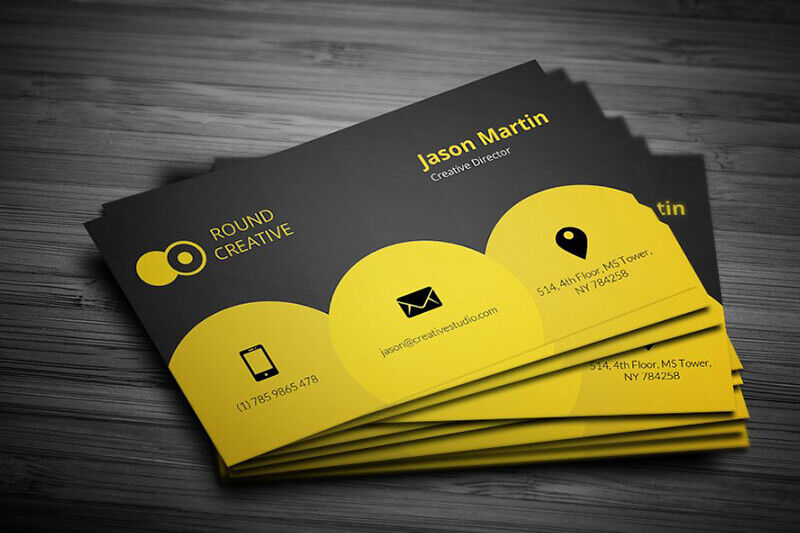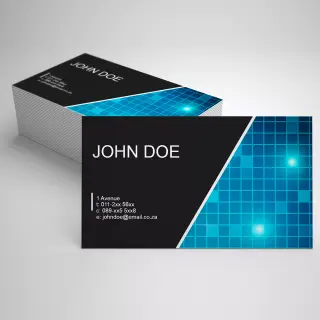Exploring Innovative Style Ideas for Effective Business Cards Printing Solutions
In today's affordable landscape, services need to separate themselves through efficient calling card designs. The option of materials, cutting-edge strategies, and unique finishes can significantly influence a card's effectiveness. Companies must take into consideration exactly how their brand identity affects these components. As they explore options, the integration of technology and sustainability likewise plays a crucial duty. What creative remedies can emerge from these considerations?
Understanding Your Brand Identification
Brand name identity offers as the cornerstone of any effective calling card layout. It includes the visual and psychological elements that stand for a service, including its logo design, color scheme, typography, and total tone. Recognizing brand name identity enables designers to produce cards that not only stand apart yet additionally reverberate with target audiences. Each element should mirror the core worths and mission of the business.For instance, a technology start-up might choose smooth, modern-day layouts with strong colors, while a law office may choose an extra traditional, understated approach. Uniformity across all branding products is essential, as it reinforces reputation and recognition. A well-crafted calling card acts as a tangible depiction of the brand name, leaving a long-term impression on potential customers or partners. By aligning style options with brand name identity, companies can efficiently connect their distinct message and develop a solid presence in their market.

Selecting the Right Materials
Picking the ideal materials for calling card considerably impacts the general impact they make. The selection of cardstock is important; thicker options convey longevity and expertise, while lighter products might recommend an extra laid-back method. Furthermore, the finish-- whether matte, glossy, or uncoated-- influences not just appearances but additionally responsive experience. Glossy finishes can enhance colors and images, producing a vibrant appearance, while matte coatings use an advanced touch and are easier to create on.Eco-friendly materials are significantly prominent, appealing to environmentally conscious clients and businesses. They can communicate a brand name's worths properly. In addition, one-of-a-kind textures or specialty materials, such as recycled paper or steel, can distinguish a calling card from competitors. Inevitably, the selected products should straighten with the brand name's identification, guaranteeing that the card not just looks appealing yet also resonates with the designated audience.
Cutting-edge Design Methods
Ingenious design strategies in calling card creation can substantially improve the influence of individual branding. Techniques such as minimalist visual appeals, distinct forms and products, and the unification of increased or interactive functions are acquiring popularity. These techniques not only record interest yet also leave a lasting impression on potential clients and partners.
Minimalist Aesthetic Strategies

Unique Forms and Products

Interactive and Enhanced Attributes
Exactly how can Business cards advance past plain contact details to involve receivers in an unforgettable way? Incorporating interactive and enhanced functions provides an engaging service. By incorporating QR codes, NFC modern technology, or increased fact elements, companies can change fixed cards into dynamic experiences. Receivers can check a code to access a portfolio, watch a video intro, or involve with interactive material that showcases the brand's individuality. Such features not just improve the card's energy yet also create a lasting impact, prompting receivers to connect even more deeply with the brand - business cards printing near me. This innovative technique not only improves calling card yet also fosters an interesting dialogue, transforming a simple exchange into a multi-sensory experience that strengthens professional connections
Typography and Color Pattern
Typography and shade plans play a crucial function in calling card design, affecting both the aesthetic charm and the effectiveness of the card. Effective font choice techniques can enhance brand name identity, while an understanding of shade psychology can evoke details emotions in possible clients. Furthermore, accomplishing the appropriate comparison and readability is important for making sure that crucial information stands out clearly.
Typeface Option Strategies
Picking the best font style for a calling card can substantially influence its effectiveness, as studies show that 65% of people form an initial impression based on aesthetic elements. Font choice ought to reflect the brand name's identity, ensuring it lines up with the general message. here Sans-serif typefaces often convey a clean and modern-day visual, making them ideal for tech-oriented services. In contrast, serif fonts can convey a sense of tradition and integrity, interesting a lot more traditional markets. In addition, legibility is vital; excessively decorative typefaces can impede readability. A well balanced technique to font dimension and spacing improves quality. When incorporating font styles, it is suggested to restrict choices to 2 corresponding styles to maintain visual consistency, thus reinforcing the brand's expertise and memorability.
Shade Psychology Insights
Color plays a pivotal duty in calling card design, affecting assumptions and feelings connected with a brand name. Each shade evokes particular feelings; for instance, blue is typically linked to trust and professionalism and reliability, making it a preferred option amongst business entities. Alternatively, red can signify passion and urgency, appealing to vibrant industries. Environment-friendly normally represents growth and sustainability, reverberating well with eco-conscious companies. Yellow, related to positive outlook and creative thinking, can bring in interest however ought to be conserved to avoid overwhelming the visitor. Recognizing these shade organizations enables designers to craft cards that not only stand apart yet likewise connect the brand's worths properly. As a result, selecting a thoughtful color design is necessary for leaving a lasting perception.
Comparison and Readability Tips
A properly designed Business card not only records interest with its color system however likewise ensures that the information presented is conveniently readable. To attain this, comparison plays an essential role. High contrast between message and history improves legibility; for example, dark message on a light history or vice versa works. Furthermore, the choice of typography considerably impacts readability. Sans-serif typefaces typically provide a modern appearance and are less complicated to review at smaller dimensions. It is recommended to limit the number of font designs to keep aesthetic coherence. Shade systems ought to be unified yet unique adequate to attract attention to crucial information, such as the name and contact information. Ultimately, stabilizing contrast and readability assures that the card leaves a lasting perception.
Including Distinct Coatings
Unique coatings can boost a company card from common to phenomenal, making a long lasting impact on recipients. Various strategies, such as embossing, debossing, and foil marking, can add structure and a responsive component that engages the detects. For instance, embossing develops an elevated layout, while debossing imprints the style right into the card, each offering an unique aesthetic appeal.Foil marking includes metallic accents that gleam, drawing interest to critical information like a logo or tagline. Additionally, matte or shiny coatings can affect the card's total feel and look; matte coatings provide a sophisticated touch, whereas shiny surfaces boost colors and images.Choosing one-of-a-kind coatings not just improves aesthetics yet also shares professionalism and focus to information. A well-finished Business card can efficiently connect a brand's identity and worths, making it an essential component of effective networking and advertising and marketing approaches.
Leveraging Modern Technology in Design
How can modern technology transform the layout of Business cards? The integration of sophisticated design software program and tools enables designers to produce cutting-edge and aesthetically striking calling card with convenience. Programs like Adobe Illustrator and Canva use easy to use interfaces and a wide variety of layouts, allowing customization to fulfill specific branding needs.Furthermore, digital printing modern technology enhances high quality and precision, enabling detailed designs and lively shades that attract attention. The use of 3D modeling and increased fact can likewise boost a calling card's impact, providing interactive experiences that engage prospective clients.Moreover, cloud-based platforms assist in collaboration amongst style teams, simplifying the comments process and ensuring that revisions are effectively executed. Inevitably, leveraging technology not only boosts the visual appeal of calling card but likewise improves their performance, making them a dynamic device for networking and brand name depiction.
Sustainability in Business Card Printing
With increasing understanding of environmental concerns, sustainability in calling card printing has acquired substantial interest among developers and businesses alike. This change is triggered by a growing need for eco-friendly practices that decrease waste and lower the carbon footprint. Developers are currently checking out products such as recycled paper, naturally degradable options, and sustainable inks made from all-natural sources.Additionally, companies are opting for digital printing methods that consume much less power and water contrasted to standard techniques. Some firms have actually started making use of minimalistic layouts that lower the quantity of ink and product required, additionally advertising sustainability.Furthermore, the rise of on-line printing solutions permits on-demand manufacturing, removing excess stock and waste. By integrating these sustainable techniques, businesses not just improve their brand photo however likewise add favorably to the environment, interesting an increasingly eco-conscious consumer base. This ongoing commitment to sustainability in Business card printing mirrors a wider trend towards accountable layout in the industry.
Often Asked Questions
The Number Of Business Cards Should I Print simultaneously?
The ideal number of calling card to publish differs based upon specific demands and budget plan. Usually, printing in between 100 to 500 cards is typical, permitting adaptability in networking opportunities without extreme wastefulness.
What Is the Average Cost of Business Card Printing?
The average cost of calling card printing varies commonly based on factors such as quantity, paper top quality, and design complexity. Typically, costs range from $20 to $200 for a standard batch of cards.
Can I Design My Calling Card Online?
Several individuals can make their calling card online making use of different straightforward platforms. These devices often offer adjustable templates, making it possible for individuals to create distinct styles that mirror their brand name identity without needing innovative graphic layout abilities.
For how long Does It Take to Publish Business Cards?
The moment needed to publish Business cards differs based on amount and printing approach. business cards printing near me. Commonly, it can draw from a couple of hours for digital prints to several days for conventional countered printing, relying on the copyright's work
What Prevail Mistakes to Prevent in Business Card Style?
Usual blunders in Business card layout include littering with extreme info, using unreadable typefaces, disregarding brand colors, overlooking card top quality, and failing to consist of essential contact information, which can lessen the card's effectiveness and professionalism. In today's affordable landscape, organizations need to differentiate themselves with effective Business card layouts. Brand identity serves as the foundation of any kind of effective Business card layout. Typography and shade plans play a vital role in Business card style, influencing both the aesthetic allure and the effectiveness of the card. Shade plays a critical function in Business card design, influencing emotions and assumptions linked with a brand. With increasing awareness of ecological issues, sustainability in Business card printing has actually gained substantial attention amongst developers and companies alike.